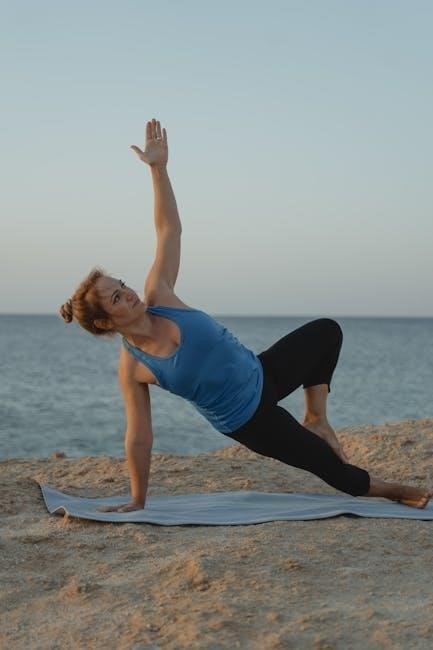Scapular dyskinesis refers to abnormal scapular motion affecting shoulder function, often linked to pain and instability. It is recognized by altered scapular position or movement patterns.
1.1 Definition and Overview
Scapular dyskinesis is a condition characterized by abnormal scapular motion or positioning, disrupting normal shoulder function. It is often associated with shoulder pain, instability, or impingement. The term “dyskinesis” refers to altered movement patterns, which can impair the scapulohumeral rhythm. Proper scapular mechanics are essential for efficient energy transfer through the kinetic chain, making this condition significant in both athletic and everyday activities. Accurate diagnosis and targeted exercises are crucial for restoring normal movement and preventing further complications.
1.2 Importance of Scapular Stability
Scapular stability is crucial for optimal shoulder function, as it provides a stable base for humeral movement. Proper scapular mechanics ensure efficient energy transfer through the kinetic chain, reducing the risk of injury and enhancing athletic performance. Instability or altered movement patterns can lead to conditions like shoulder impingement, rotator cuff strain, and chronic pain. Addressing scapular dyskinesis through targeted exercises is essential to restore normal movement, prevent complications, and improve overall upper limb function.
1.3 Common Causes and Risk Factors
Scapular dyskinesis often arises from muscle imbalances, poor posture, or repetitive overhead movements. Weakness in stabilizing muscles like the serratus anterior and trapezius can disrupt scapular mechanics. Risk factors include prolonged sitting, sports involving overhead activities, and prior shoulder injuries. Additionally, individuals with rounded shoulders or forward head posture are more susceptible. Addressing these underlying issues is critical to preventing progression and promoting effective rehabilitation through targeted exercises.
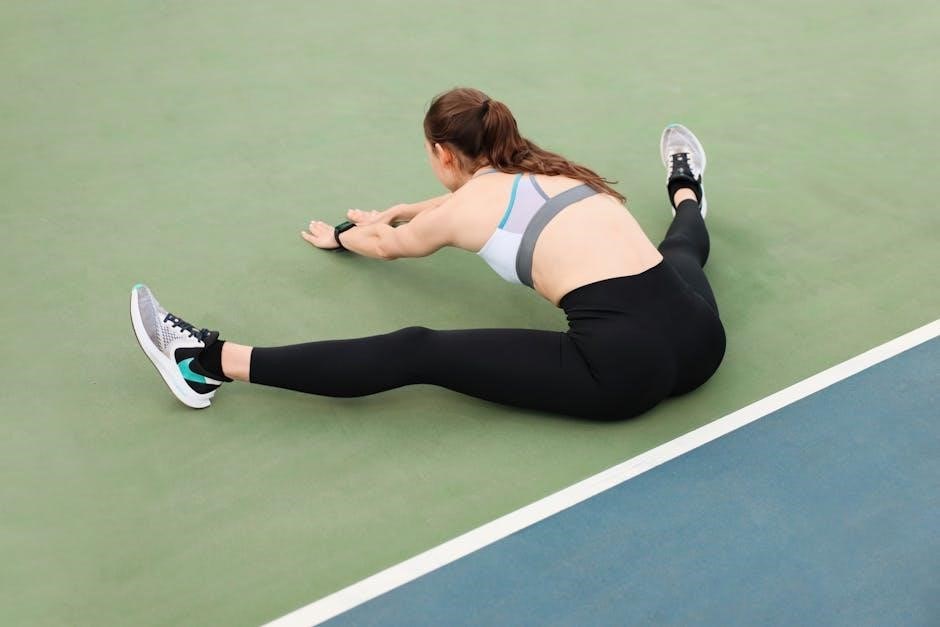
Understanding Scapular Dyskinesis
Scapular dyskinesis is characterized by altered scapular motion and position, often linked to muscle imbalances, affecting shoulder stability and movement efficiency.
2.1 Signs and Symptoms
Common signs of scapular dyskinesis include visible winging of the shoulder blades, altered posture, and limited shoulder mobility. Patients often experience pain during overhead movements or arm elevation. Weakness in the periscapular muscles, poor scapulohumeral rhythm, and compensatory movement patterns are frequently observed. Symptoms may worsen with repetitive activities, leading to decreased functional performance and discomfort in daily tasks or sports. Early identification of these signs is crucial for implementing targeted exercises to restore proper scapular mechanics and prevent further complications.
2.2 Differential Diagnosis
Scapular dyskinesis must be differentiated from other shoulder conditions, such as subacromial impingement, adhesive capsulitis, or rotator cuff injuries. While it often coexists with these pathologies, its distinct presentation involves altered scapular motion and posture. A thorough clinical assessment, including physical exams and movement analysis, is essential to confirm the diagnosis. Proper differentiation ensures targeted treatment, focusing on restoring scapular stability and addressing related muscle imbalances. Accurate diagnosis is critical for developing effective exercise programs tailored to scapular dyskinesis.
2.3 The Role of Scapular Stabilization
Scapular stabilization is crucial for restoring normal movement patterns and reducing pain. It involves strengthening the muscles around the scapula, such as the trapezius, rhomboids, and serratus anterior, to improve their coordination and endurance. Proper stabilization enhances the scapula’s ability to act as a stable base for shoulder movements, reducing strain on the rotator cuff. Exercises like scapular holds, wall slides, and shoulder blade squeezes are fundamental in re-establishing dynamic stability. This foundation is essential for addressing scapular dyskinesis and preventing further shoulder dysfunction, making it a cornerstone of rehabilitation programs.
Phases of Scapular Rehabilitation
Rehabilitation progresses through phases: pain reduction, strengthening, and functional movements. Each phase targets specific muscle activation and mobility to restore normal scapular function and movement patterns.
3.1 Phase I: Scapular Stabilization and Pain Reduction
Phase I focuses on reducing pain and restoring basic scapular stability. Exercises like scapular holds, wall slides, and shoulder blade squeezes are commonly used to activate stabilizing muscles. These exercises minimize stress on the shoulder joint while promoting proper muscle activation patterns. Manual therapy and gentle mobilizations may also be incorporated to improve mobility and reduce stiffness. The goal is to create a stable foundation for more advanced movements in subsequent phases, ensuring pain-free and efficient scapular function. This phase is crucial for addressing acute symptoms and preparing the shoulder for progressive loading.
3;2 Phase II: Strengthening and Motor Control
Phase II focuses on strengthening the scapular muscles and improving motor control. Exercises such as side-lying scaption raises, prone scapular stabilization, and bird dogs are introduced to enhance muscle endurance and coordination. These movements target the rotator cuff and periscapular muscles, promoting proper scapulohumeral rhythm. Patients are encouraged to perform 3 sets of 10-15 repetitions for each exercise, ensuring controlled movements. The goal is to improve strength, reduce compensatory patterns, and prepare the shoulder for more dynamic activities. Progression is tailored to individual needs, emphasizing functional movements that enhance overall shoulder stability and performance.
3.3 Phase III: Advanced Strengthening and Sports-Specific Training
Phase III emphasizes advanced strengthening and sports-specific training to restore high-level function. Exercises like medicine ball throws, scapular push-ups, and plyometric drills are introduced to enhance power and endurance. Dynamic movements mimic sports-specific actions, improving reaction time and coordination. Resistance bands and functional equipment are incorporated to simulate real-world demands. Progression focuses on explosive movements, ensuring proper scapular mechanics during high-intensity tasks. The goal is to prepare the shoulder for return to sport or rigorous activities, emphasizing optimal performance and injury prevention. This phase bridges rehabilitation with competitive demands, ensuring seamless integration of strength and function.

Scapular Stabilization Exercises
Scapular stabilization exercises focus on strengthening muscles like the serratus anterior and trapezius to restore normal scapular movement. Techniques include scapular holds, wall slides, and shoulder blade squeezes.
4.1 Scapular Holds
Scapular holds are foundational exercises to improve scapular stability. They involve squeezing the shoulder blades together and holding the position to activate stabilizing muscles. Perform by sitting or standing tall, squeezing shoulder blades without shrugging, and holding for 5-10 seconds. Breathe naturally, avoiding tension. Start with 3 sets of 10 repetitions, gradually increasing duration as strength improves. Focus on maintaining proper posture to ensure effectiveness. This exercise helps restore scapular control and reduces dyskinesis symptoms by targeting the trapezius and rhomboid muscles. Consistency is key for lasting improvement in scapular function and overall shoulder stability.
4.2 Wall Slides
Wall slides are effective for improving scapular mobility and stability. Stand facing a wall with palms flat at shoulder height. Slowly slide arms upward, keeping hands in contact with the wall, while maintaining proper posture. Avoid shrugging or arching the back. Hold for 5 seconds, then lower arms slowly. Perform 3 sets of 10 repetitions. Focus on controlled movements to engage scapular stabilizers without compensating. This exercise enhances scapular upward rotation and reduces dyskinesis by promoting proper movement patterns. It is ideal for early-stage rehabilitation and can be progressed by varying arm positions or adding resistance.
4.3 Shoulder Blade Squeezes
Shoulder blade squeezes target the scapular stabilizers, improving posture and reducing winging. Sit or stand tall with arms at your sides. Squeeze shoulder blades together without moving your arms, holding for 5 seconds. Release slowly and repeat 10-15 times for 3 sets daily. Focus on engaging the trapezius, rhomboids, and levator scapulae muscles. This exercise enhances scapular stability, reduces pain, and improves muscle activation. It is beneficial for addressing poor posture and early signs of scapular dyskinesis, promoting proper scapular movement and strength.
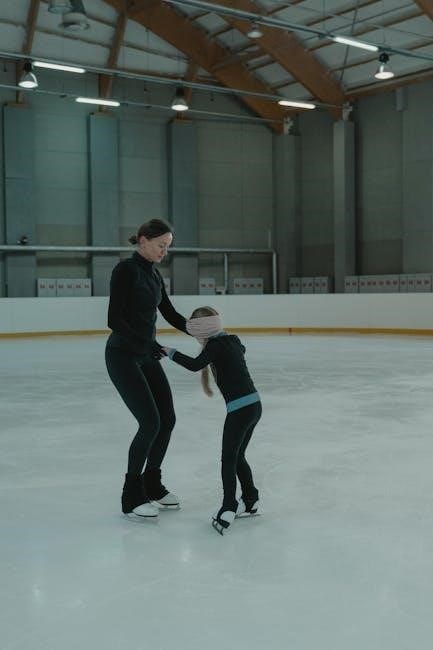
Strengthening Exercises for Scapular Muscles
Strengthening exercises for scapular muscles target the trapezius, rhomboids, levator scapulae, and serratus anterior. These exercises improve scapular stability, enhance posture, and address dyskinesis effectively.
5.1 Side Lying Scaption Raise
The side lying scaption raise is an effective exercise for strengthening the supraspinatus muscle and improving scapular mobility. Lie on your side with knees bent, placing the unaffected hand on your opposite shoulder for stability. Slowly lift the affected arm overhead, keeping the elbow straight, and hold for 3-5 seconds. This exercise enhances scapular upward rotation and reduces dyskinesis symptoms. Perform 2-3 sets of 10-12 repetitions daily to strengthen the shoulder and improve functional movement patterns. Proper form is essential to avoid compensatory movements and maximize muscle activation.
5.2 Prone Scapular Stabilization
Prone scapular stabilization is a foundational exercise targeting the muscles that stabilize the scapula. Lie on your stomach with arms extended overhead, then slowly lift your arms off the ground while squeezing your shoulder blades together. Focus on maintaining a neutral spine and engaging your core. This exercise strengthens the rhomboids, trapezius, and levator scapulae, improving scapular stability and reducing dyskinesis. Perform 3 sets of 10-15 repetitions, holding the position for 2-3 seconds. Progress by adding resistance or increasing arm elevation to challenge the stabilizing muscles further. Proper form ensures effective muscle activation and injury prevention.
5.3 Bird Dogs
Bird Dogs are an effective exercise for improving scapular stability and core coordination. Start on your hands and knees in a quadruped position, engage your core, and extend one arm and the opposite leg simultaneously. Maintain a neutral spine and avoid letting your hips or shoulders sag. Hold for 2-3 seconds, then slowly return to the starting position. This exercise enhances scapular control, strengthens the periscapular muscles, and promotes proper movement patterns. Perform 3 sets of 10-15 repetitions on each side, focusing on controlled movements to maximize scapular stability and reduce dyskinesis.
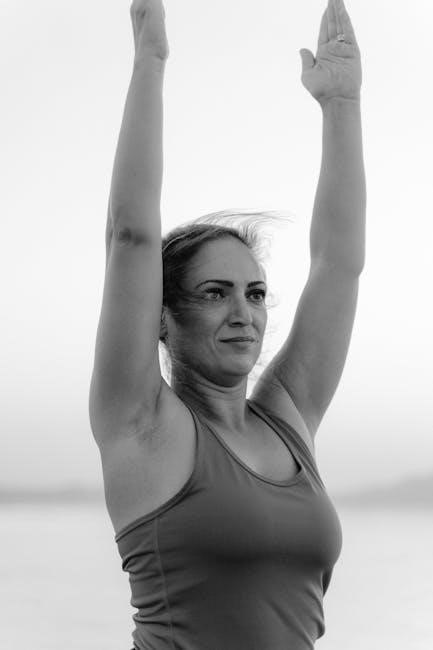
Dynamic and Functional Exercises
Dynamic exercises enhance scapular mobility and strength through functional movements, improving shoulder mechanics and reducing dyskinesis. Examples include shoulder clocks and Ts/Ys, which promote proper scapulohumeral rhythm and stability.
6.1 Shoulder Clocks
Shoulder clocks are dynamic exercises that enhance scapular mobility and strength by simulating clock-like arm movements. Stand with arms extended, palms forward, and move arms in a circular motion, as if drawing a clock face. This exercise improves scapulohumeral rhythm, reducing dyskinesis. Perform 2-3 sets of 10-12 repetitions in both clockwise and counterclockwise directions. Focus on controlled movements to maintain proper scapular stability. Progress by increasing range or resistance. Shoulder clocks are ideal for functional rehabilitation, preparing the shoulder for complex movements and sports-specific actions. They also enhance kinetic chain coordination, essential for overhead activities and daily functions.
6.2 Ts and Ys
Ts and Ys are foundational exercises targeting the scapular and rotator cuff muscles. Begin by standing tall with arms extended in a “T” position (palms down) and transition to a “Y” position (palms forward). These movements improve scapular mobility, strength, and coordination. Perform 2-3 sets of 10-15 repetitions, focusing on controlled movements and proper form. Progress by adding resistance or increasing range of motion. Ts and Ys enhance scapulohumeral rhythm, reducing dyskinesis and improving shoulder function. They are versatile for rehabilitation and sports training, promoting dynamic stability and functional movement patterns.
6.3 Dynamic Hugs with Resistance Bands
Dynamic Hugs with Resistance Bands target the serratus anterior and other scapular stabilizers. Place the band around your torso at chest height, holding the ends in each hand. Engage your core, squeeze your shoulder blades together, and push your arms forward in a hugging motion. Focus on controlled movement and full scapular protraction. Perform 2-3 sets of 10-15 repetitions. This exercise enhances dynamic scapular stability, improves posture, and strengthens the muscles necessary for overhead activities. It is highly effective for addressing scapular dyskinesis and promoting functional shoulder movement.
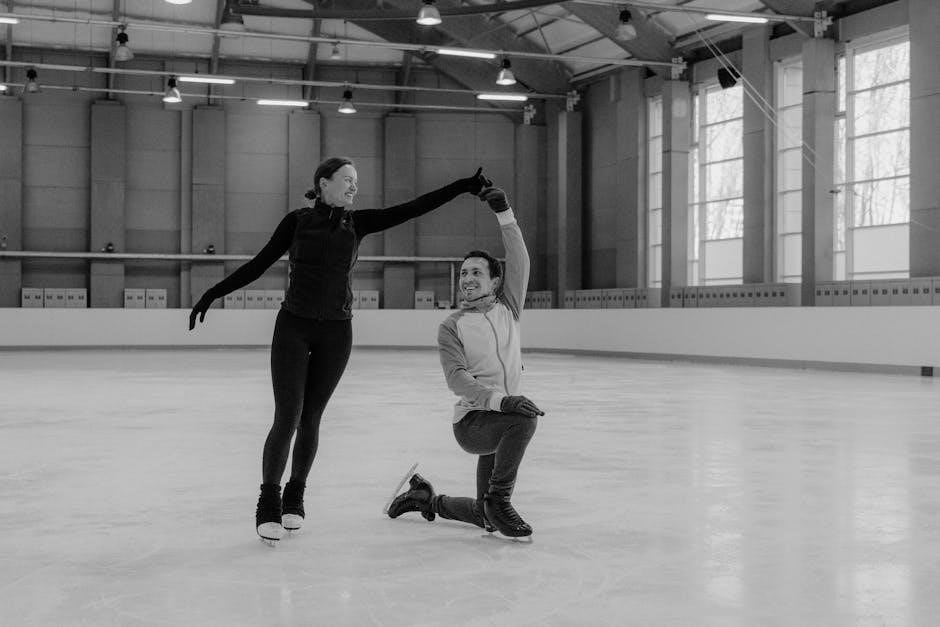
Core and Kinetic Chain Integration
Core and kinetic chain exercises enhance scapular stability by integrating movements of the hips, trunk, and shoulders. Planks, quadruped, and hip movements improve coordination and overall stability.
7.1 Plank Variations
Plank variations are essential for strengthening the core and improving scapular stability. They engage the lower trapezius, serratus anterior, and abdominal muscles, enhancing shoulder stability. Start with elbow planks, holding for 30-60 seconds. Progress to lateral planks, targeting the obliques and scapular stabilizers. Dynamic planks, such as shoulder taps or leg lifts, challenge stability and coordination. Perform 3 sets of each variation, focusing on proper form to avoid compensation. Incorporate planks 3-4 times weekly to enhance kinetic chain integration and overall scapular function.
7.2 Quadruped Exercises
Quadruped exercises, such as alternate arm and leg raises, target scapular stabilization and core engagement. Start on hands and knees, engaging the lower trapezius and serratus anterior. Raise one arm and the opposite leg, maintaining a neutral spine. Progress to dynamic movements, like bird dogs, to enhance motor control. These exercises improve scapular symmetry and strength, reducing dyskinesis. Perform 3 sets of 10-12 repetitions. Focus on slow, controlled movements to avoid compensatory patterns. Incorporate variations, such as adding resistance or instability, to challenge advanced levels. Quadruped exercises are foundational for restoring scapular and trunk coordination in rehabilitation programs.
7.3 Hip and Trunk Movements
Hip and trunk movements are integral to scapular stabilization, as they promote kinetic chain integration. Exercises like lunges with dumbbell reaches emphasize coordination between the hips, trunk, and scapula. Hip abduction in side-lying positions strengthens gluteal muscles, which support proper scapular mechanics. Trunk rotations and extensions enhance core stability, essential for maintaining scapular symmetry. These movements improve timing and coordination, reducing dyskinesis risk. Perform 2-3 sets of 8-10 repetitions, focusing on controlled transitions. Incorporate dynamic exercises like step-ups or rotational movements to advance training, ensuring proper scapular function during complex activities.
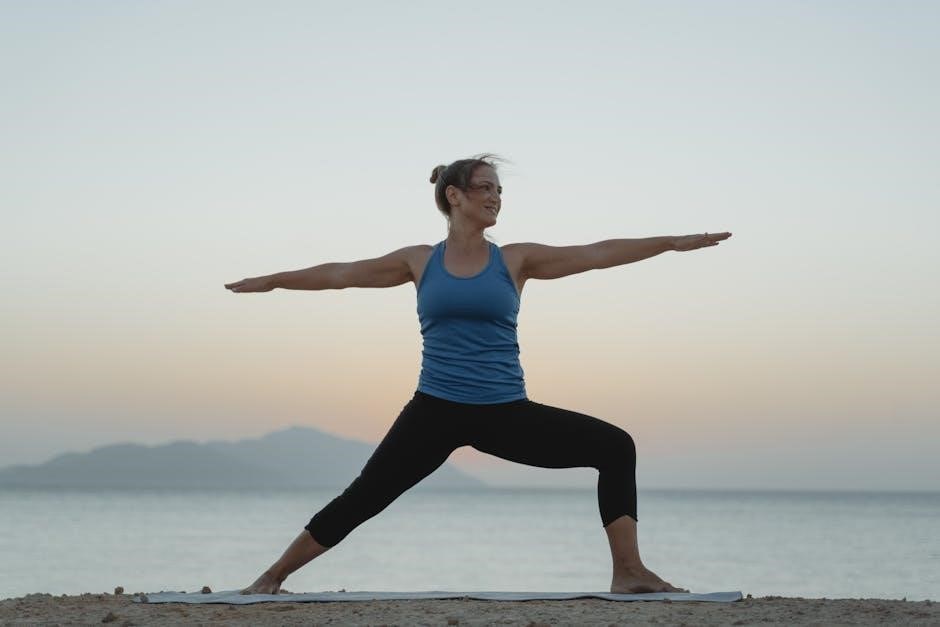
Stretching and Mobility Exercises
Stretching and mobility exercises target tight muscles around the scapula, improving flexibility and posture. Focus on posterior capsule and pectoralis minor stretches to enhance shoulder mobility and reduce tension. Perform 2-3 sets, holding each stretch for 20-30 seconds. Regular stretching helps maintain proper scapular alignment and prevents dysfunction. Incorporate dynamic stretches, such as arm circles, to promote active mobility. Consistency is key to achieving long-term improvements in scapular movement and overall shoulder health.
8.1 Posterior Capsule Stretching
Posterior capsule stretching targets the tight muscles and connective tissue at the back of the shoulder joint. To perform, stand in a doorway with arms extended overhead and hands on the doorframe. Gently lean forward, stretching the posterior capsule for 20-30 seconds. Repeat 2-3 times. This stretch improves shoulder mobility and reduces tension contributing to scapular dyskinesis. Consistency helps maintain proper scapular alignment and prevents recurrence. Incorporate this stretch 1-2 times daily for optimal results. Regular practice enhances flexibility and promotes balanced shoulder mechanics.
8.2 Pectoralis Minor Stretching
Pectoralis minor stretching targets the muscle beneath the pectoralis major, often tight in scapular dyskinesis. To perform, stand in a doorway with one arm extended overhead, palm facing forward, and grab the doorframe. Lean away from the door gently until a stretch is felt in the front of the shoulder. Hold for 20-30 seconds and repeat 2-3 times on each side. This stretch reduces pectoralis minor tightness, improving scapular alignment and reducing forward head posture. Regular practice helps restore proper shoulder mechanics and alleviate dyskinesis symptoms.
8.3 Scapular Mobilization Techniques
Scapular mobilization techniques involve manual therapy to restore normal scapular motion and reduce stiffness. Techniques such as joint mobilizations, soft tissue releases, and rhythmic oscillations are commonly used. These methods target the scapulothoracic joint and surrounding tissues to enhance flexibility and range of motion. Manual therapy can address restrictions in scapular rotation and elevation, improving overall shoulder mechanics. Regular mobilization can reduce muscle tension, enhance posture, and promote proper movement patterns, making it an essential component of scapular dyskinesis rehabilitation. When combined with exercises, it helps restore functional movement and prevents further dysfunction.

Plyometrics and Advanced Training
Plyometrics and advanced training involve high-intensity exercises to enhance scapular function, dynamic stability, and explosive power. Techniques like medicine ball throws and explosive push-ups improve functional movement patterns.
9.1 Medicine Ball Throws
Medicine ball throws are plyometric exercises that target the scapular muscles, enhancing explosive power and dynamic stability. They involve throwing the ball with force, engaging the core and scapular stabilizers. Proper technique ensures the scapula remains retracted and controlled during the movement. Start with lighter weights and progress to more dynamic throws. This exercise improves functional strength and prepares the shoulder for high-intensity, sports-specific actions. Regular practice helps restore normal scapular mechanics in advanced rehabilitation phases.
9.2 Scapular Push-Ups
Scapular push-ups are advanced exercises targeting the serratus anterior and trapezius muscles, essential for scapular stability. Perform by starting in a plank position, engaging the core, and maintaining a straight line from head to heels. Lower the body slightly, then push back up, focusing on scapular protraction and retraction. Avoid winging or losing form. This exercise improves scapular control and strength, benefiting both rehabilitation and athletic performance. Progress to plyometric variations, such as explosive push-ups, to enhance dynamic strength and power. Proper technique ensures effectiveness and prevents injury, making it a key component of advanced scapular training programs.
9.3 Sport-Specific Movements
Sport-specific movements are tailored exercises mimicking actions of particular sports to restore scapular function and athletic performance; These drills focus on replicating game-like scenarios, such as throwing, overhead reaches, or change-of-direction movements. They are integrated into advanced rehabilitation programs to enhance scapular control, strength, and timing. Examples include medicine ball throws for overhead athletes and dynamic lateral movements for field sports. Progression involves increasing intensity and complexity, ensuring proper scapular mechanics to reduce injury risk and improve performance. These exercises bridge the gap between basic strengthening and real-world athletic demands, making them essential for athletes returning to play.
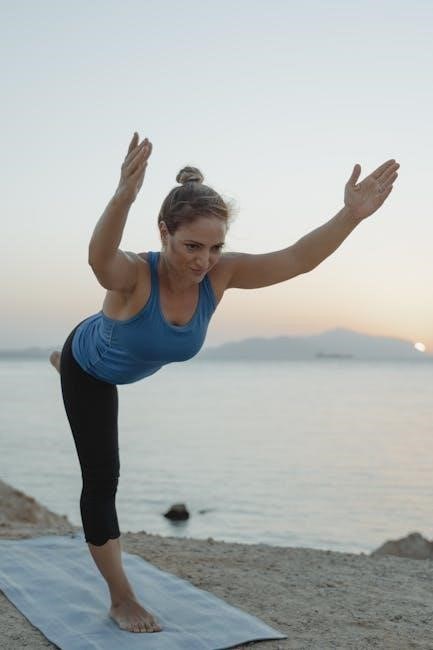
Case Studies and Clinical Applications
Case studies demonstrate scapular dyskinesis exercises improving outcomes in overhead athletes, office workers, and post-surgical patients. These exercises enhance recovery, prevent recurrence, and restore functional mobility in diverse populations.
10.1 Scapular Dyskinesis in Overhead Athletes
Scapular dyskinesis is prevalent among overhead athletes, such as baseball pitchers and swimmers, due to repetitive stress and altered movement patterns. Common issues include winging, poor scapular rotation, and decreased stability. Exercises like dynamic hugs, scapular holds, and wall slides are effective in restoring scapular mechanics. Strengthening the rotator cuff and periscapular muscles, along with improving core stability, helps reduce injury risk and enhances performance. Proper exercise progression ensures athletes maintain optimal shoulder function and mobility, preventing long-term damage and promoting recovery.
10.2 Scapular Dyskinesis in Office Workers
Office workers are prone to scapular dyskinesis due to prolonged sitting, poor posture, and repetitive computer use. This leads to muscle imbalances, with weakened scapular stabilizers and tight pectoral muscles. Common symptoms include neck and shoulder pain, reduced mobility, and difficulty performing daily tasks. Exercises such as shoulder blade squeezes, wall slides, and pectoralis minor stretches are effective in addressing these issues. Strengthening the upper back and improving postural awareness can help alleviate discomfort and restore proper scapular function. Regular movement breaks and ergonomic adjustments are also crucial for long-term prevention.
10.3 Scapular Dyskinesis in Post-Surgical Patients
Post-surgical patients, particularly those undergoing shoulder or neck surgeries, are at risk for scapular dyskinesis due to immobilization, pain, and altered movement patterns. Gentle exercises like scapular holds and wall slides are often recommended to restore mobility and strength. Manual therapy, including soft tissue mobilization and joint mobilizations, can address stiffness and promote proper scapular mechanics. Progressive resistance exercises, such as shoulder blade squeezes and prone scapular stabilization, help rebuild muscle control. Early intervention and gradual progression of exercises are crucial to prevent long-term complications and ensure successful recovery, emphasizing pain-free movement and functional restoration.
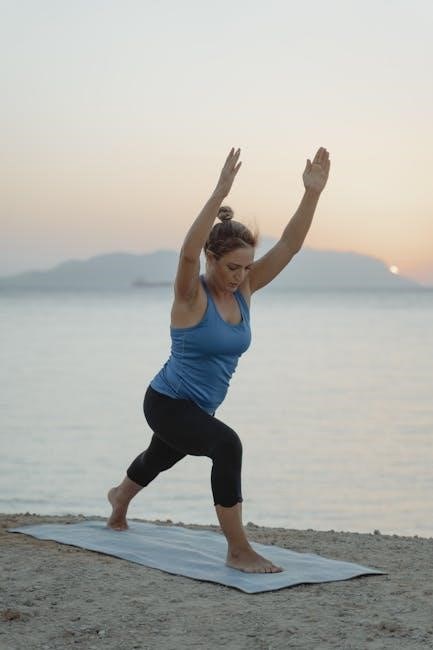
The Role of Physical Therapy
Physical therapy addresses scapular dyskinesis through manual techniques, strengthening exercises, and patient education, promoting proper movement and reducing pain for effective recovery.
11.1 Manual Therapy Techniques
Manual therapy techniques are essential in addressing scapular dyskinesis, focusing on improving joint mobility and soft tissue flexibility. Techniques include soft tissue mobilization of the periscapular muscles to reduce tension and promote relaxation. Joint mobilization is used to enhance scapular movement and correct alignment. Trigger point therapy targets tight muscle fibers to relieve pain and improve range of motion. These hands-on methods, combined with exercise, help restore proper scapular mechanics, reducing discomfort and enhancing functional movement patterns for effective rehabilitation.
11.2 Exercise Progression
Exercise progression for scapular dyskinesis follows a structured approach to enhance strength, stability, and functional movement. Initial phases focus on scapular stabilization, such as holds and wall slides, to improve motor control. As strength increases, exercises like dynamic hugs and resistance band rows are introduced to challenge scapular muscles. Advanced training incorporates plyometric movements and sport-specific drills to restore dynamic function. Progression is gradual, ensuring proper technique and symptom-free performance. The goal is to transition from controlled exercises to functional activities, optimizing scapular mechanics and reducing injury risk.
11.3 Patient Education and Compliance
Patient education is critical for effective scapular dyskinesis management. Teaching proper exercise techniques, posture awareness, and pain-free movement patterns ensures adherence to rehabilitation programs. Providing clear instructions and visual guides, such as PDF exercise manuals, enhances understanding and compliance. Emphasizing the importance of consistent practice and gradual progression helps patients maintain motivation. Compliance is key to restoring scapular function, preventing recurrence, and achieving long-term stability. Educating patients on their role in recovery empowers them to take an active part in their rehabilitation journey, fostering better outcomes and sustained improvement.
Effective scapular dyskinesis management combines targeted exercises and patient education. Future research should explore advanced techniques and long-term maintenance strategies to enhance outcomes.
12.1 Summary of Key Concepts
Scapular dyskinesis exercises are essential for restoring normal scapular motion and reducing pain. Key concepts include strengthening periscapular muscles, improving scapulohumeral rhythm, and enhancing core stability. Early phases focus on stabilization, while advanced training incorporates dynamic movements and sport-specific drills. Consistency and proper technique are crucial for long-term success. These exercises not only address dyskinesis but also prevent future shoulder injuries by promoting optimal scapular function and kinetic chain integration.
12.2 Emerging Trends in Scapular Rehabilitation
Emerging trends in scapular rehabilitation emphasize personalized exercise programs and advanced techniques. 3D motion analysis and wearable technology are increasingly used to monitor scapular movement patterns. Integrating core and kinetic chain exercises with scapular-focused drills enhances overall stability. Manual therapy, such as soft tissue mobilization, is gaining prominence alongside traditional strengthening exercises. Sport-specific training and plyometric exercises are now being incorporated earlier in rehabilitation protocols to improve functional outcomes. These innovative approaches aim to address scapular dyskinesis more effectively, promoting faster recovery and long-term shoulder health.
12.3 The Importance of Long-Term Maintenance
Long-term maintenance is crucial for sustaining improvements in scapular function and preventing recurrence of dyskinesis. Consistent practice of stabilization and strengthening exercises ensures lasting stability. Patient education on proper posture and movement patterns is essential. Gradual progression of exercises, even after symptoms resolve, helps maintain muscle strength and coordination. Neglecting maintenance can lead to relapse, emphasizing the need for a lifelong commitment to scapular health. Regular follow-ups with physical therapists can tailor programs to individual needs, ensuring continued progress and overall shoulder functionality.
